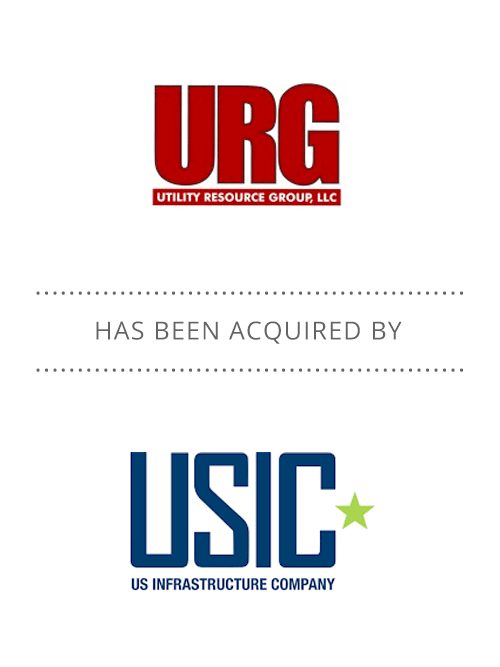Industrial Services and Infrastructure
TABLE OF CONTENTS:
- CH. 1: Introduction
- CH. 2: Market Overview & Trends
- CH. 3: Key Players in the Utility and Industrial Services M&A Market
- CH. 4: Factors Driving an M&A Transaction, and Key Process Considerations
- CH. 5: What Buyers Look for in a Utility or Industrial Services Business
- CH. 6: Key Considerations for Growing Your Utility or Industrial Services Business Through Acquisition
- CH. 7: How to Raise Capital for Your Utility or Industrial Services Business
Chapter 1
Introduction to the Utility Services and Industrial Services Sectors
The utility services and industrial services sectors are experiencing the benefit of several noteworthy tailwinds—from increasing capex budgets in response to aging infrastructure and a growth in domestic manufacturing, public funding for new long-term infrastructure initiatives, greater outsourcing in the face of labor scarcity, new technological solutions, and more. With an attractive growth outlook over the next decade, and a scarcity of quality assets available for sale, these industries remain active for investment across financial sponsors and strategic acquirors seeking new sources of growth.
If you own a business in one of these sectors, you may be wondering whether current market conditions make it a good time to sell the company or take on a majority investor. And if you’re thinking about taking your company to market, you’re probably interested in knowing what you should consider before making that decision.
This guide to M&A in the utility and industrial services sectors can help answer your most pressing questions. It reviews the key trends and directions in these industries, the factors that make them attractive to investors, the key M&A players, and recent deal activity. The guide also provides insights on what buyers look for in a utility or industrial services business, what to think about before selling your company or acquiring a business in these categories, how to raise capital, and why Forbes is the right partner to help you achieve an exceptional outcome when you’re ready to exit the business or need to raise capital.
Both the utility services and industrial MRO industries have exhibited resilience in market growth over recent years. Expenditures on gas and electricity distribution infrastructure have grown by trailing 5-year CAGRs of 10.8% and 11.6%, respectively.
Chapter 2
Market Overview & Trends
The utility and industrial services sectors comprise a diverse range of companies delivering a wide variety of service types.
Within utility services, the category includes gas detection, locating, meter reading, infrastructure inspection and repair; electricity infrastructure repair and field services; vegetation management; field technology; engineering & construction services; and integrity testing & inspection.
Within industrial services, the category includes providers of maintenance, repair, and overhaul (MRO) services; plant management; remediation services; industrial cleaning; and a variety of installation and commissioning services.
Both the utility services and industrial MRO industries have exhibited resilience in market growth over recent years. Expenditures on gas and electricity distribution infrastructure have grown by trailing 5-year CAGRs of 10.8% and 11.6%, respectively, driven by increased end-market demand, the need to replace aging infrastructure and the broader stresses from the realities of renewable transition and climate change events. In the industrials services space, MRO spending with the manufacturing sector is expected to grow by 7.8% annually over through the end of this decade.
A combination of trends is underlying this growth:
-
- Aging Infrastructure. Industry commentary across gas and electricity networks indicates a substantial need for upgrade. In the electricity grid, capacity growth has failed to keep up with energy demand, while managing infrastructure averaging 40 years of age. The gas industry shares the same challenges with 35% of pipelines sharing a similar age profile – the estimated 75,000 miles of pipeline deemed “leak-prone” by regulators represents over 20 years of repair backlog for utilities.
- Focus on Grid Stability and Enhanced Regulatory Scrutiny. The combination of a growing level of climate change events, along with the instability inherent in the addition of renewable energy sources into power grids have resulted in a greater focus by utilities on improving levels of reliability and service quality to consumers. This comes alongside efforts by regulatory bodies in the enforcement of mandatory grid reliability standards.
- Supportive Government Spending Initiatives. Efforts like the Infrastructure Investment and Jobs Act are infusing funds to support large infrastructure projects related to high-speed Internet delivery, clean water access, and power grid upgrades, among others. This, along with predecessor programs, is expected to continue to support capital spending by utilities and ultimately, work with utility services providers.
- Increased Outsourcing In the Face of Challenging Labor Markets. Given the estimated 25%+ of utility workers retiring within the next ten years, and the lack of skilled labor resources more broadly, the industry has accelerated its adoption of the outsourcing model, providing access to cost effective solutions while meeting regulatory requirements for reliability.
- Access to New Technological Solutions. From smart technologies, security challenges and automated workflows to the Internet of Things (IoT), utility and industrial operations are more complicated than ever, requiring specialized labor to keep complex equipment and other assets operating reliably. At the same time, digital transformation efforts in both sectors require a wide range of services to ensure effective implementation and support.
- Growth in Domestic Manufacturing from Re-Shoring. With more manufacturing shifting back to North America, as a means of diversifying sourcing and minimizing supply chain risks, there is a corresponding increase in demand for the industrial services these businesses depend on.
The same trends that are driving demand for utility and industrial services have attracted the attention of investors. While deal volume is not quite at the peak levels of 2021, M&A activity remains robust, with a great deal of capital available. Uncovering investable situations where a company has long-term relationships and a critical mass in field operations is increasingly difficult, giving established businesses an advantage when engaging in potential transaction dialogue. And with organic growth increasingly difficult to achieve due to the scarcity of available labor, growth by acquisition is a common strategy.
The latter is driving continued consolidation in both the utility services and industrial services sectors. When large services businesses succeed in securing new contracts but struggle to staff them, acquiring a smaller competitor is often the best solution—enabling them to scale without the challenges of attracting and retaining staff. Growth by acquisition also helps businesses in these sectors to innovate faster and more cost effectively, leveraging acquired technologies and labor to expand and enhance their offerings. Not surprisingly, businesses that offer a compelling technology story—especially related to efficiency improvements and operational savings—have had little trouble garnering investors’ interest at attractive market valuations.
Ready to Discuss Selling Your Utility Services or Industrial Services Company?
Chapter 3
Key Players and Deal Activity Within the Utility and Industrial Services M&A Market
Though macroeconomic headwinds prevail, strategic and financial acquirers view utility and industrial services as appealing sectors to deploy their capital. There may be fewer A+ target companies available at the moment, but strong deals are still possible in this healthy, competitive environment.
M&A activity in these sectors has been led by private equity (PE) groups with active infrastructure and services platforms and larger strategic competitors alike. The latter includes companies such as infrastructure services providers, engineering & consulting players and diversified industrial services companies.
PE groups have been especially active in this space in the last several years, as evidenced by deals like the following:
-
- Center Rock strengthened its portfolio with the addition of Power Services Group, a provider of turbine generator MRO services primarily to the power, industrial and petrochemical markets.
- Ridgemont Equity Partners announced the acquisition of Sparus Holdings, concurrent with OneVision Utility Services, providers of field services (inspection, metering and locate), as a platform for consolidation of service providers across utility and industrial end-markets.
- PowerTeam Services’ (Re-branded Artera Services) acquisition by Clayton, Dubilier & Rice, and subsequent acquisition of five follow-on transactions, creating an integrated, national platform serving the gas and electric utility industries.
- Acquisition of Industrial Service Group Holdings by The Jordan Company, a network of companies focused on the repair, service and sale of critical process rotating equipment.
Strategic acquirers also have been busy purchasing quality companies in the utility and industrial services sectors, seeking to build platforms of critical scale, leverage consolidation opportunities, access new contracts or markets, and cross-sell new services.
For example:
-
- Primoris acquired Future Infrastructure Holdings, a provider of maintenance, repair, upgrade, and installation services to the telecommunications, gas utility and infrastructure markets, in a deal valued at $620 million (a 9.0x multiple). Primoris cited the ability to establish a platform in the growing telecommunication services market as well as valuable cross-selling opportunities.
- Clean Harbors purchased HydroChemPSC, an industrial cleaning, specialty maintenance and utilities services provider, at a 10.7x multiple, noting an opportunity to achieve significant cost synergies and drive revenue through cross-selling.
- USIC Locating Services expanded its geographic reach and bolstered its field workforce with the acquisition of Utility Resource Group, a provider of underground utility locating, gas leak detection, meter, sewer lateral inspections, and cross bore mitigation services for utilities and municipalities.
- MasTec, Inc. acquired Henkels & McCoy Group Inc., a leading utility services and contracting company focused on gas distribution, power, communications and energy midstream end-markets, for approximately 8.6x EBITDA. This transaction allowed MasTec the opportunity to enhance exposure to the growing renewables utility services space, as well as broader grid modernization work.
The availability of capital (both equity and debt) remains strong for quality companies in the utility and industrial services sectors, so deal activity is expected to remain stable or grow through at least year-end. Though fewer quality targets are available—due to consolidation or reluctance or lack of readiness to sell—the most desirable businesses are commanding higher-than-expected valuations in many cases.
Overall, these sectors remain resilient in the face of market pressures and macroeconomic headwinds, with deal flow being driven by strategics and PE-owned platforms seeking opportunities to access new markets, customer segments, technologies, and talent.
Specific deal valuations and multiples vary significantly based on the type of business and other factors. The greatest drivers of deal value in these sectors include:
-
- Strong contracted or recurring revenue—ideally with multi-year contract terms and/ or 50-70% of annually recurring revenues
- Technology-based applications and services
- Customer base diversity, with no more than 20-30% of revenue concentrated in a single customer or contract
- 100 or more employees
- Limited reliance on set-aside status such as minority businesses enterprise (MBE), women-owned business (WOB), veteran, or disabled, although such status can prove advantageous in securing some public sector contracts
Most M&A transactions in these sectors involve a small privately owned business consolidating into a large entity with an existing capital structure, fully transitioning within a time horizon of 12-18 months. Deal values may range from 6-8.0x+ EBITDA, depending on the company’s size and contract profile. Companies with EBITDA greater than $5 million, as well as those with especially strong contracts and/or unique technologies, are likely to command premium multiples.
However, the high cost of capital is impacting valuations in some cases, while also increasing the odds that a transaction will involve greater structure within its mix of total consideration. And with economic uncertainties still looming, due diligence now takes longer and involves much greater scrutiny, which has extended overall deal timelines.
Chapter 4
Factors Driving an M&A Transaction, and Key Process Considerations
Founders and owners of well-established companies in the utility or industrial services sectors are likely to view an acquisition as appealing in certain circumstances.
For some, the lack of a clear or viable path to generational transfer may be an issue, especially if they’ve reached a point in their lives where retirement is calling. Others are able to achieve success, but with a defined capital need for their next phase of growth, owners choose to find a new partner in the execution of this long-term vision.
On the opportunity side, founders of utility or industrial services businesses may find their company’s industry reputation, customer relationships and operating profile provides a strong foundation for attracting investor attention. Consistently strong valuations in the current market—driven by scarcity value and access to unique strategic competencies —also is leading owners of utility and industrial services companies to consider taking the business to market.
Selling your utility or industrial services business is likely to be a life-changing event. Before proceeding, it’s important to keep these key considerations in mind.
-
- Longer Deal Timelines: Due diligence processes are more stringent, leading to longer completion times.
- Buyer’s Time Horizon: Your intended time horizon for exiting the business will impact the type of buyer you attract and the deal structure. Do you hope to leave the business soon after the transaction closes or are you looking to stay on and roll over some equity for another payout later? Make sure you’re clear on your goals before starting the sale process.
- Transaction Partner: Consider what you’re looking for. For many founders, it’s important to sell to a buyer that will take care of employees long after the deal closes, preserve their brand, and maintain their company values.
- Investment Thesis: Develop your key investment thesis when going to market, and work in advance to develop asset of key performance indicators (KPIs) that match this marketing message. Thoroughly review your KPIs and determine where any improvements are needed before you go to market.
- Customer Relationships: Buyers look to reduce their risk by acquiring businesses with solid, diversified contracted customer relationships. Take the time now to expand your client base and bolster your contracts where needed.
- Management Team: Buyers also expect a strong management team in place and a workforce capable of strong operational execution. Now is the time to address any key gaps in your organizational chart.
The better prepared you are for the due diligence process, the more smoothly it will proceed. Start preparing early by compiling the necessary due diligence materials, including a Quality of Earnings report.
Chapter 5
What Buyers Look for in a Utility or Industrial Services Business
Strategic competitors and private equity groups alike continue to focus on M&A as a core component of their long-term growth. Companies with a confident outlook toward their businesses are able to take advantage of the current environment to acquire access to new customers, adjacent service offerings or novel technologies.
These buyers seeking a target business in the utility or industrial services sectors typically look for characteristics that may include the following:
-
- A stable, diversified customer base and contract mix, supporting recurring revenues
- Track record for consistent growth and stable margin development within a target’s core business, with the potential for the addition of new adjacent service offerings
- Critical mass of employees across a field organization, preferably with the right tenure, training and safety record
- Predictable capital spending profile within a scalable operating platform
- Innovative technological solutions, improving efficiency or drive down costs
- Demonstrated ability to respond to emerging customer needs
Chapter 6
Key Considerations for Growing Your Utility or Industrial Services Business Through Acquisition
Founders and business owners may have a long-term vision for their company before contemplating an exit and may be able to accelerate achieving that vision by acquiring a competitor, an adjacent service provider, or a strategic player with access to a unique and desirable corporate competency.
The factors that drive acquirors to buy a utility or industrial services company are similar to those that will propel you to acquire a sector competitor. If growth through M&A is central to your business strategy, it will be important to prioritize key criteria during the review of a target’s operations and financial profile.
Key characteristics may include:
-
- The scale of the business’ field operations, including employee profile, asset composition, and equipment profile
- A diversified mix of services, key customers, and portfolio of contracts
- The corporate infrastructure and ability to support future growth, either organically or through M&A, without incremental capital investment
- Expansion opportunities and synergies for the combined entity, through new customers, attractive markets, and cross-selling
- High levels of recurring revenue from existing customers and stable gross margins, given cost trends relative to current contracts
- Differentiating use of technology in field operations that may be applied to the acquiring business’s existing operations
Along with these essential characteristics, be sure to look for a target company that is serious about selling and shares your core values and objectives. While the numbers need to make sense, it’s equally vital to find a partner you can work with effectively for the long term.
Chapter 7
How to Raise Capital for Your Utility or Industrial Services Business
Your business may have a defined capital need for the next phase of strategic growth, which could delay your ultimate exit. Alternatively, you might be looking to de-risk your personal finances, “taking chips off the table” concurrent with raising new capital to support your long-term plan. Whatever your objective, there are several viable options for raising capital or unlocking liquidity without exiting the business entirely, which may serve as a good steppingstone to an eventual sale once you’re ready.
The two main types of capital are debt and equity, with each presenting advantages and disadvantages:
Debt capital typically takes the form of bank lending, although some middle market businesses also consider mezzanine financing. While the process to obtain debt capital is relatively fast and straightforward, it can prove a more expensive route, especially in times of rising interest rates. You also need confidence that your current and forecasted future cash flow will be sufficient to service incremental new debt.
Equity capital involves taking on an investor in exchange for providing a minority stake in the business (assuming you’re not selling the business outright). Since minority investments can be structured in many different ways, with many factors to consider, this is a more complicated approach to raising capital than taking on debt. For example, the investor might require a seat on your board and veto power over significant decisions, such as whether you can sell the business.
The optimal solution will depend on a number of factors, both personal and external to financing and capital markets.
First, you must have confidence in future levels of financial flexibility and be open to a new reality in governance and corporate control alongside new stakeholders. New capital, whether debt or equity, must fit the current capital structure and the existing variances in a normal operating environment, which could be seasonal, cyclical, or customer specific. Finally, debt financing and PE markets may point to the best partner and outcome based on the company’s collateral profile, how you intend to use the proceeds, and the risks inherent in reaching long-term milestones for cash flow growth.
The capital formation process is complex, but a strategic advisor can guide you to the best outcome. Together, you and your investment banking partner will discuss your objectives for raising capital and intended use of the proceeds. Then your advisor will recommend the best capital structure to achieve your goals, market your business to appropriate capital sources, and negotiate and finalize the best terms.
The Forbes Guide to Middle Market Capital Formation offers a comprehensive view on this subject, providing a valuable resource for utility and industrial services business owners looking to raise capital.
How Forbes Partners Can Help
Within the current macro and industry environment, utility and industrial services companies continue to attract strong levels of investor attention. Owners of A+ companies within these sectors will find it a good time to take their businesses to market, as long as they have a strong partner to guide them in achievement of an exceptional outcome.
For many utility and industrial services companies, Forbes Partners is the ideal advisor. The investment banking team at Forbes has deep knowledge of these sectors and experience helping owners find the right buyer and achieve the best outcome, including for owners of MBE and WOB companies. We have access to the right mix of financial and strategic buyers, along with strong relationships and ongoing contact with many of the leading players. Forbes also has a strong track record for leading exceptional deals in this space, including serving as an advisor to Utility Resource Group in its sale to USIC and assisting G2 Integrated Solutions in its sale to EN Engineering
Equally as important, the Forbes team understands the challenges and opportunities underlying the current transaction environment, so we know how to craft a compelling growth story and defendable position that will attract the right buyer, premium valuation, optimal structure, and an exceptional outcome.
Talk with Forbes.
Exceptional utility and industrial services businesses need an exceptional investment bank. Forbes Partners has the expertise to exceed expectations and achieve optimal outcomes for you.
Forbes Partners is an award-winning middle market investment banking firm focused on driving maximum value to clients. We help our clients restructure debt or recapitalize their business to meet evolving needs. Many owners desire liquidity while still maintaining control of their businesses. Forbes Partners can help them achieve their goal. Our experienced bankers think strategically about value creation — we are market makers, and our clients expect nothing less.













